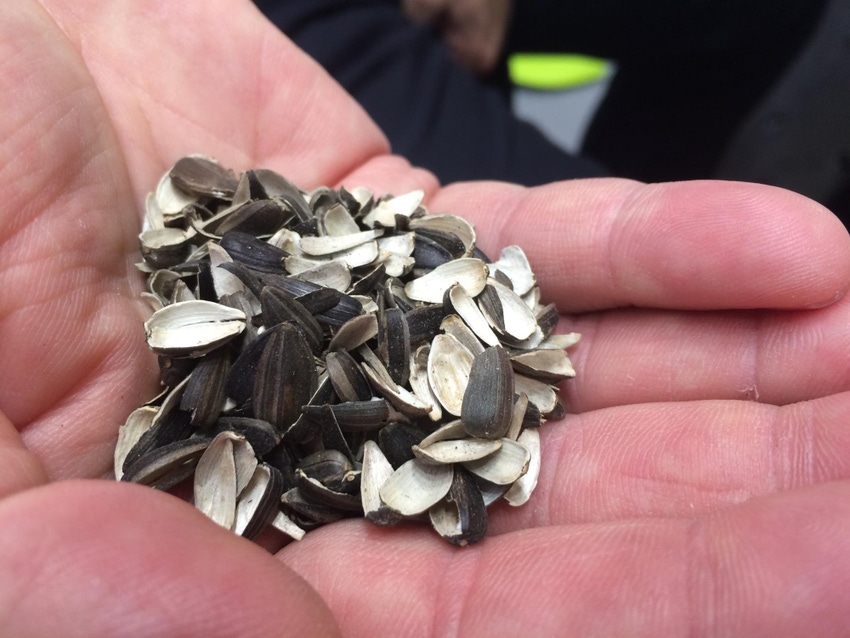Golden Compound harnesses sunflower power to create fiber-filled biocompound
The Fakuma trade show earlier this month saw the debut of a start-up called Golden Compound GmbH (Ladbergen, Germany), a company that has found a way to valorize a residual product that, up until now, was mostly burned. The company, a 50/50 joint venture between Cargill (Wayzata, MN) and Germany-based SPC GmbH, was set up for the purpose of developing, producing and commercializing fiber-reinforced bioplastic compounds based on sunflower seeds. Or to be more specific: on sunflower seed hulls.
October 28, 2015

The Fakuma trade show earlier this month saw the debut of a start-up called Golden Compound GmbH (Ladbergen, Germany), a company that has found a way to valorize a residual product that, up until now, was mostly burned. The company, a 50/50 joint venture between Cargill (Wayzata, MN) and Germany-based SPC GmbH, was set up for the purpose of developing, producing and commercializing fiber-reinforced bioplastic compounds based on sunflower seeds. Or to be more specific: on sunflower seed hulls. Sunflower hulls are the by-product of the dehulling of sunflower seeds before they are used for oil extraction or other purposes. Lightweight and bulky, they are often burned as fuel or used as a garden material or as roughage for cattle and sheep. During an interview with PlasticsToday, Marcel Dartée, General Manager at Golden Compound said: “They are a perfect choice: sunflower hulls are available in infinite quantities; they are a side product that does not compete with the food supply, and sustainable, with special benefits that you don’t get with other natural fibers.”
Sunflower hulls are the by-product of the dehulling of sunflower seeds before they are used for oil extraction or other purposes. Lightweight and bulky, they are often burned as fuel or used as a garden material or as roughage for cattle and sheep. During an interview with PlasticsToday, Marcel Dartée, General Manager at Golden Compound said: “They are a perfect choice: sunflower hulls are available in infinite quantities; they are a side product that does not compete with the food supply, and sustainable, with special benefits that you don’t get with other natural fibers.”
Golden Compound was established in June 2014, the result of a business relationship between two companies who were already active in the sunflower business and who believed in the potential of sunflower hulls. “The starting point is the sunflower,” said Dartée. “We grind the hulls of the sunflower seeds into fiber. Fiber is a functional additive in plastics, and applications can use fiber loadings from 30 up to 70%. Thirty-five percent is typical, and PP is the typical matrix used,” he explained.
The company developed and is marketing compounds under the brand S²PC, which is shorthand for Sustainable Sunflower Plastic Compound. Compounds are available with either PP or PLA matrices. Post-consumer recycled PP options are also available. And, while the current compounds have been especially developed for injection molding, other grades are under development.
The natural color of the compounds is dark, with a visible fiber structure. However, the compounds are easily colored—a pure black office product was on display at the stand—using regular carbon black.
The initial pilot plant was up and running by Oct. 1 of last year, and has since been scaled up to a capacity of 2.5 metric tons/year today. The company is currently determining the size and site for its industrial factory. “We are confident about the product, based on the results achieved,” Dartée declared. “We’ve tested the compounds in several markets: they’ve been used in a number of furniture applications—chair backs, supports for office furniture—as well as in office supply products, such as desk trays.”
“Interestingly, we are finding that we provide the stiffness needed to replace certain materials, such as PS (in the case of the desk tray), or even PA. A manufacturer of office furniture has now replaced the PA formerly used in the back support of an office chair with our PP fiber-filled compound,” he added. Even more interestingly, such conversions have been made at equal or lower cost.
So, what are the benefits of the new fiber? According to Dartée, one of the most important is the fact that fibers from ground sunflower seed hulls have inherent foaming properties, which enhances the filling behavior. “This means that when molding thicker products, you get no sink marks. There is no need to overfill the part, or for high back pressure. This is truly an improvement,” he said.
“Also, next to providing stiffness, significantly shorter cycle times—up to 50%—are possible for thick products, because of the excellent heat dissipation properties of the material.”
Golden Compound’s S²PC materials also have a lower density and are lighter in weight compared to, for example, glass-filled compounds. “Combinations have also been used,” said Dartée. “Using a 30% loading of sunflower hulls together with a 20% glass fiber loading in PP, can replace 40% glass fiber while retaining all mechanical properties. Not only does the density go down—so less weight—but the cycle time is also reduced.”
Next to furniture and office supplies, Golden Compound is targeting markets, such as warehouse elements—crates, boxes—and the horticultural market—flower pots and gardening accessories—with its compounds. The horticultural market offers particular potential for the company’s fiber-filled PLA compound. Other developments are in the pipeline.
“We’ve got our eye on a number of automotive interior applications, where we could replace glass fiber-reinforced PP,” said Dartée.
“We can truly make a difference on performance,” he said.
“We offer a sustainable product with a biobased component, or even a 100% biobased compound, at a price that is on parity with conventional oil-based materials—or lower. But, ultimately, it’s all about performance. Performance is what counts, not what it’s made of. Because in the end, the only reason people will be willing to switch, is if it works.”
About the Author(s)
You May Also Like


